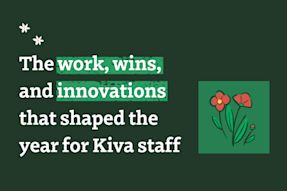Transitioning farmers away from cocaine-producing crops in Peru
March 23, 2018By: Michael Light

Nestled in the center of Peru is a lush valley region defined by 3 rivers, with a notorious reputation as ‘cocaine valley.’
Peru is the world’s largest producer of cocaine, and nearly 70% of the coca leaves used to produce the narcotic are grown in the valley region, known by the acronym VRAEM.
COOPAC Microfinanzas Prisma, a new Kiva Field Partner based in Lima, has 2 branches deep in the VRAEM region, serving some of the poorest and most financially excluded populations in the country. The VRAEM was one of the hardest hit areas during the Peruvian civil war in the 1980s and ‘90s, and as such is still recovering, lagging behind the rest of the country in infrastructure construction and development.
The majority of COOPAC MFP’s clients are from this region, and most are women living and working in rural communities who need access to working capital, savings accounts, a variety of trainings and micro-insurance.
 A Kiva borrower in Peru
A Kiva borrower in Peru The organization also works with farmers and families in the VRAEM who are transitioning or have transitioned from coca production to growing alternative crops, such as cocoa, vegetables or coffee. Providing farmers with capital and business support is vital work, because they’ve been treated as collateral damage in both drug-related crime as well as coca eradication campaigns waged by the United States and Peruvian governments.
In 2013, Peru’s President Ollanta Humala began deploying paramilitaries to the VRAEM under pressure and with funding from the U.S. government, with the intent to reign in cocaine production and destroy coca plants by hand.
In the process, it’s estimated that about 100,000 families who relied on coca production have had their livelihoods affected by the government’s reduction policy, with 10,000 families’ livelihoods estimated to be totally destroyed.
And while, according to the Peruvian state, tens of thousands of families annually receive financial support or assistance cultivating alternative crops after their coca fields are destroyed, many of the families affected by eradication get no assistance, or have deemed the government’s offered reparations insufficient, and turn them down.
The reason is simple: coca production is far more profitable than the cultivation of alternatives, and margins for crops like cocoa, coffee, vegetables or palm oil are thin. Because of a high saturation of financial organizations along Peru’s coast, and low concentration of financial institutions in Peru’s center, loans for individuals and families cultivating these crops are difficult to come by.
 A Kiva borrower making affordable furniture for low-income families in Peru.
A Kiva borrower making affordable furniture for low-income families in Peru. Kiva’s partnership with COOPAC MFP has helped expand the organization's existing loan programs to better serve individuals and families transitioning out of the coca trade, as well as launch new agricultural and housing loans. As a result, in the years since its foundation COOPAC MFP has broadened their client base in underserved regions like the VRAEM, and have become unique in offering housing loans to their target population.
COOPAC MFP also has branches in the city of Pucallpa in the Amazon’s Ucayali region as well as in the northern San Martin region’s city of Tarapoto. Now, with the support of Kiva and its lenders, the organization has plans to expand again, broadening its reach and giving more access of loans to those in need.
You can find borrowers supported by COOPAC MFP here, and find borrowers from our other Field Partners in Peru here.
PREVIOUS ARTICLE
Refugees and finance: Out of sight, out of mind? →NEXT ARTICLE
Links We Like: Fashion statements with a social conscious →












